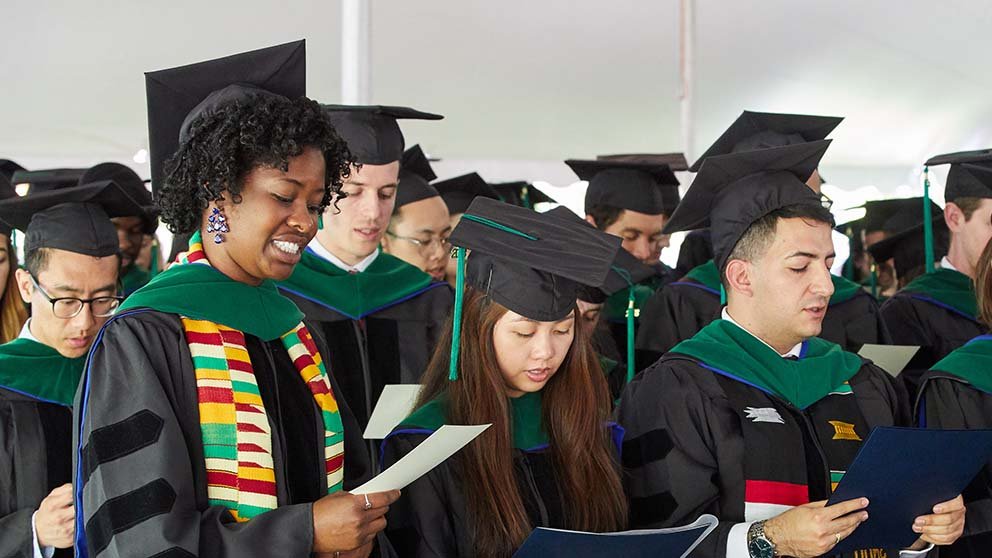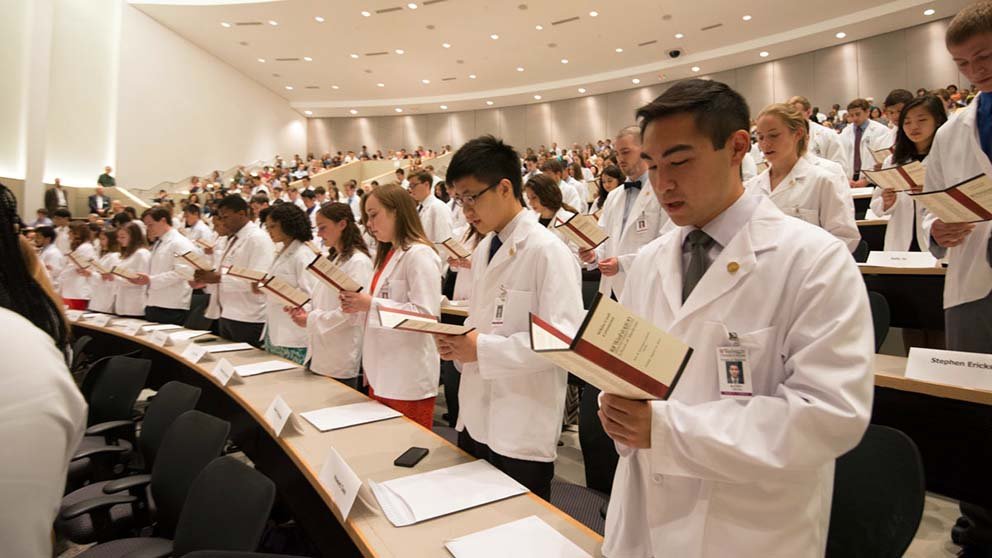
Each year, thousands of graduating medical students across the country don caps and gowns and vow to uphold the highest ideals of their new profession. The uninitiated might assume they recite the Hippocratic Oath, a venerable document enumerating ideals for physicians that dates back more than two millennia. In reality, though, that’s hardly the case.
While nearly all U.S. medical school graduations include a public promise, and some use an updated version of Hippocrates’ words, not a single student utters the original Hippocratic Oath.
Instead, today’s medical students recite a vast — and growing — range of oaths. In 2015, more than half of medical school graduations featured an oath unique to that school, compared to 9% in 1982, according to a 2017 Academic Medicine study. What’s more, students increasingly work together before graduations and white coat ceremonies to choose or craft their own oaths, creating a personalized declaration of what it means to be a physician.
“It’s so inspiring every year to see this group of wonderful people come together and commit themselves to the higher ideals for which they are aiming.”
Colleen Wallace, MD
Washington University School of Medicine
Whether borrowing bits from existing oaths or starting from scratch, these students arrive at vows that often blend longstanding ethical values with a range of evolving social and medical issues.
Gratitude, humility, honesty, the shedding of biases, and the pursuit of lifelong learning — all these and more appear. Sometimes, though rarely, there’s also a reference to God.
Students and faculty across the country laud the oath-creation process. “It’s so inspiring every year to see this group of wonderful people come together and commit themselves to the higher ideals for which they are aiming,” says Colleen Wallace, MD, who has led the oath-creation process for five years at Washington University School of Medicine (WUSM) in St. Louis. “It’s inspirational and humbling.”
Exploring and making history
Modernizing the Hippocratic Oath is an age-old tradition. In fact, experts believe the tweaking began not long after the oath first appeared.
In more recent times, a few other oaths became popular. One, the 1948 Declaration of Geneva, was drafted by the World Medical Association after Nazi physicians conducted barbarous medical experiments. It promises never to act “contrary to the laws of humanity.” Another, a 1964 oath penned by Tufts University School of Medicine Dean Louis Lasagna, MD, emphasizes prevention over cure and a more holistic approach to medicine.

But it was only around 20 years ago that schools began to allow students to craft their own promises.
Nancy Angoff, MD, remembers the decision to discard Yale’s long-standing oath back in 2000. "Some students and I didn’t care for the language,” says Angoff, associate dean for student affairs. “It seemed very impersonal, cold, and too pat.” At first, they considered reverting to the Hippocratic Oath.
“We debated it,” recalls Angoff. “The students didn’t want to promise things they couldn’t deliver on” that the ancient oath included, so they opted to write their own pledge.
Now Yale is among the 17% of surveyed schools that have an annual process for writing, revising, or selecting an oath. At Yale, the oath is written during a pregraduation course, explains Angoff. Each year, she says, “the students end up with a really personal and beautiful oath.”
“The writing process forces you to step back and think about what it means to be a physician. It was a special moment to recite our oath knowing the thought and care we put into it.”
Karri Weisenthal, MD
Yale School of Medicine Class of 2018
Across the country, the range of oaths — from newly created to more traditional — reflect nearly two dozen different values, notes Steven Scheinman, coauthor of the 2017 Academic Medicine article. He and his team pored over 105 oaths looking for common themes. “What struck me is that not a single element is in 100% of the oaths,” he says.
Still, he adds, Hippocrates’ legacy does endure. “Four fundamentals from the original — respecting patient confidentiality, avoiding harm, respecting teachers, and upholding the integrity of the profession — appeared in the majority of the oaths.”
Connie Gan, a second-year student who helped write a WUSM white coat ceremony oath, notes a few contemporary themes: patient advocacy, interprofessional teamwork, and striving to erase unconscious biases.
She also points to a growing focus on physician self-care. “Something that came up for us is the importance of remembering that in order to take care of others, you must make sure that you’re taking care of yourself,” she says.
Oath-building 101
Sometimes, a freshly minted school decides it ought to have a brand-new oath. That’s what happened at Central Michigan University College of Medicine. So, in 2013, Executive Director of Student Affairs Charmica Abinojar gathered student volunteers to lead the creative effort.
She provided the seven students with a few existing oaths as models. “I just want to give you a flavor,” she noted. “I don’t want you to cut and paste from the existing ones, just like you wouldn’t cut and paste your wedding vows.”
The group started by identifying some essential values, explains Kathryn White, MD, one of the authors. They noted these on oversized Post-it Notes and fleshed out each with additional details. Then they distributed the themes among the volunteers, edited drafts over several months, and shared the document for their classmates’ input.
Finally, they had it: the inaugural oath they felt captured the new school’s mission and vision. Among other key themes, it stressed inclusivity, compassion, innovation, and social responsibility. “We wanted to highlight the values of our college, but we also wanted … everyone to feel their voice was heard,” White explains.
The value of social justice featured prominently in the WUSM oath she helped write, says Gan. She attributes that largely to a required week of study and service in the St. Louis community, where the high-profile police shooting of Michael Brown occurred. “Learning more about what happened here and how it affected the community was pretty impactful. Students recognized how systemic inequality can really affect patients,” says Gan. “The justice wording in our oath is our way of saying we recognize our duty to become advocates for our communities.”
The good, the bad, and the messy of oath-making
Karri Weisenthal, MD, a recent Yale grad, says helping write her oath made the words much more meaningful. “The writing process forces you to step back and think about what it means to be a physician,” she notes. “It was a special moment to recite our oath knowing the thought and care we put into it. I even teared up a bit.”
For Emily Merfeld, MD, a recent WUSM graduate, writing a white coat ceremony oath during orientation offered a chance to learn about her classmates’ varied backgrounds and perspectives. “You got to know who people were and what they were passionate about from the very start,” she says.
But oath-building is not without its downsides, some note.
“Local ownership and pluralism and diversity have their place, but at what cost?” asks Lauris Kaldjian, MD, PhD, coauthor of a 2018 study on oaths and director of the bioethics and humanities program at the University of Iowa Carver College of Medicine, where the curriculum includes content on the school’s oath. Says Kaldjian, “Consistency would help society see that physicians are members of a profession that’s committed to a shared set of essential ethical values.”
There’s certainly value in definitive, universal obligations, agrees Scheinman. “It might be a really good thing if there was one standard oath,” he says. “The problem is I don’t know how we’d come to that one oath.”
Whatever oaths include, Scheinman hopes they impress upon graduates a weighty sense of responsibility. “They’re not merely accepting a degree and recognition of hard work successfully completed,” he says. “They are progressing along a continuum in which everything they have done and will do is for the benefit of their patients.”
